As a new parent, seeing your baby’s skin can be both amazing and worrying. We might think newborn skin is perfect, but most babies are born with some marks or rashes. These skin issues are usually not serious and go away by themselves. It’s key to know what’s normal and when to get help.
In the first weeks and months, your baby’s skin is getting used to the outside world. This change can cause dry patches, rashes, and blemishes. Seeing these might worry you, but most are temporary and don’t need a lot of treatment.
Key Takeaways
- Newborn skin can have a variety of temporary blemishes and rashes as it adapts to the external environment.
- Most common baby skin conditions are harmless and clear up on their own or with gentle care.
- Understanding the prevalence and causes of these conditions can help put parents’ minds at ease.
- Proper skin care, including gentle bathing and moisturizing, is key to managing baby’s delicate skin.
- Seeking medical advice is recommended for persistent or severe skin issues to rule out any underlying conditions.
Introduction to Baby Skin Conditions
Prevalence and Importance
Babies often face various skin issues. These common problems affect many infants. It’s key for parents to know about them to keep their babies happy and healthy.
In the first few months, babies’ skin is especially sensitive. They can get everything from mild rashes to serious skin problems. Spotting these issues early and getting the right care is vital for their skin health.
Every year, over 12 million kids see doctors for skin problems. Most of these visits are to primary care doctors. This shows how common skin issues are in babies and why knowing about neonatal skin care is important.
| Skin Condition | Prevalence | Importance |
|---|---|---|
| Cradle Cap | Extremely common in young infants after birth | Can cause discomfort and flaky skin on the scalp |
| Baby Acne | Common, caused by hormonal changes | Can present as small bumps or pustules on the skin |
| Eczema | Common in babies, potentially caused by sensitivities | Can lead to dry, scaly skin or red bumps that can blister |
| Warts, Molluscum, and Other Growths | Also common in infants, some being contagious | Require identification and proper management |
Knowing the signs of these conditions is crucial for parents. It helps them care for their babies’ skin. By staying informed, parents can act quickly to keep their babies’ skin healthy and comfortable.
Milia and Baby Acne
As a new parent, you might see milia and baby acne on your newborn. These look scary but are usually harmless and short-lived.
Milia are small, white bumps on a baby’s nose, chin, or cheeks. They happen when dead skin cells get stuck under the skin. Half of all newborns get milia, which show up a day or two after birth. They don’t come from hormones and go away in two to three weeks without treatment.
Baby acne, or neonatal cephalic pustulosis, is small red and white bumps on a newborn’s face and neck. It’s caused by hormones and peaks at four to six weeks. Unlike milia, it can cause swelling. But remember, it’s common and goes away in a few months.
If your baby’s milia or acne doesn’t get better or looks worse, talk to your pediatrician. They can help with skin care and see if treatment is needed to avoid scarring.
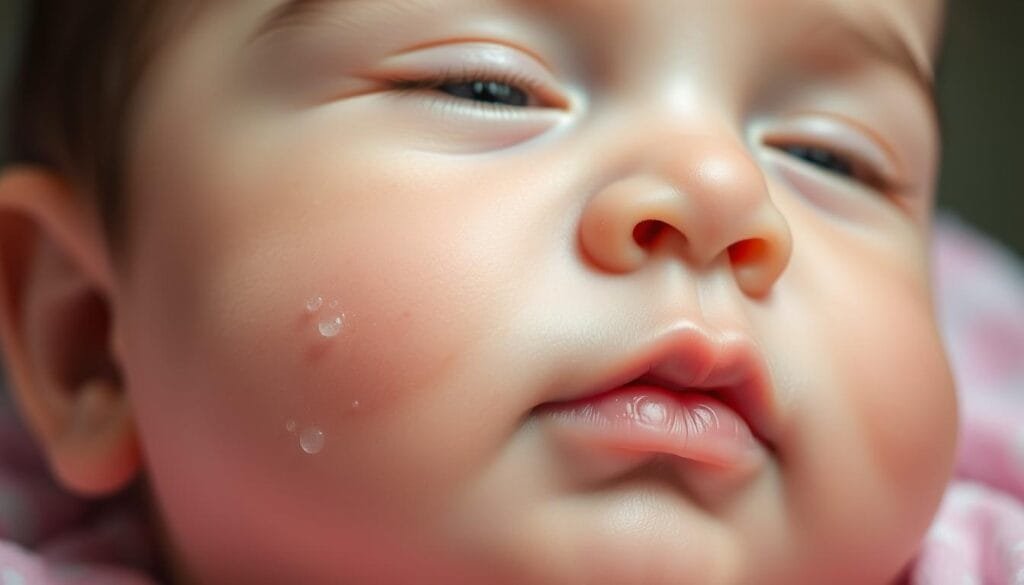
Erythema Toxicum and Pustular Melanosis
As a new parent, seeing your baby with a new skin condition can worry you. But, not all newborn rashes are serious. Erythema toxicum and pustular melanosis are usually harmless and go away on their own.
Erythema toxicum shows up at birth or soon after. It looks like small, white or yellow bumps on a pink or red base. It’s common, affecting 48% to 72% of full-term babies.
Pustular melanosis looks like small, yellowish-white spots that dry and peel off quickly. While not much is known about how common it is, it has been seen in newborns.
Identifying Benign Newborn Rashes
Both erythema toxicum and pustular melanosis are safe and don’t need treatment. Knowing what these look like can ease your mind and prevent unnecessary doctor visits. Here’s how to spot them:
- Erythema toxicum: Small, firm, yellow-white bumps with a pink base, often on the face, trunk, and arms.
- Pustular melanosis: Small, yellowish-white spots that dry and peel off, usually on the face, neck, and upper chest.
Remember, erythema toxicum and pustular melanosis are just a few of the many common infant skin conditions. Knowing these harmless rashes can give you peace of mind and prevent unnecessary doctor visits.
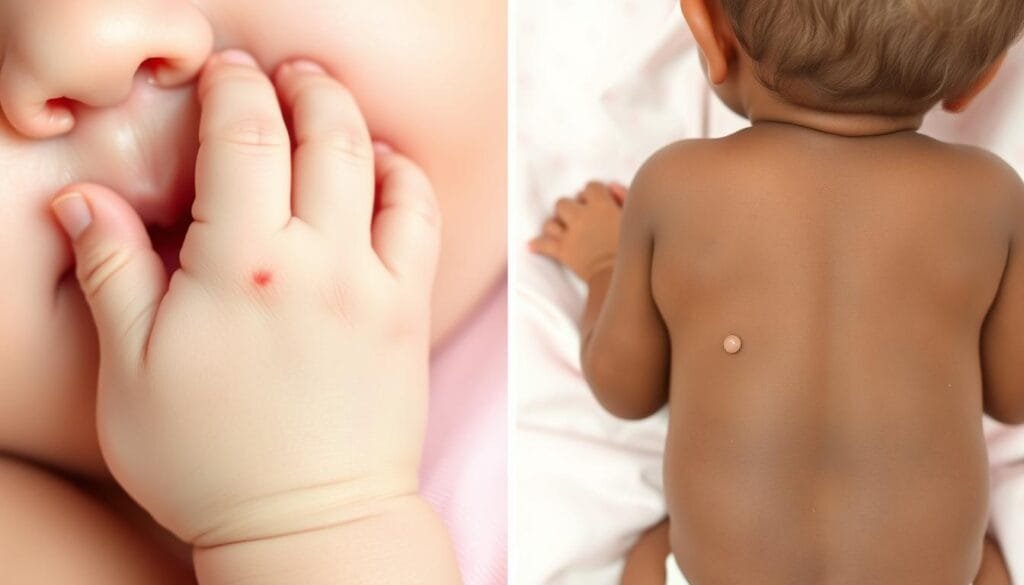
baby skin conditions
As a new parent, you may face various baby skin conditions. Cradle cap and eczema are two common ones.
Cradle Cap: Understanding Infant Seborrheic Dermatitis
Cradle cap, or infant seborrheic dermatitis, is a condition that causes scaliness and redness on a baby’s scalp. It starts in the first weeks of life. It can look bad, but it’s usually harmless and goes away by itself in a few weeks or months.
Eczema: Addressing Atopic Dermatitis
Eczema, or atopic dermatitis, shows up as dry, itchy, scaly red patches on a baby’s skin. These patches often appear around the elbows or knees. While many kids grow out of it, some may need medical help to manage it. Keeping your baby away from things that might trigger it and using gentle moisturizers can help.
It’s crucial to watch for these baby skin conditions and get medical help when needed. Knowing about these common issues helps you care for your baby’s skin better.
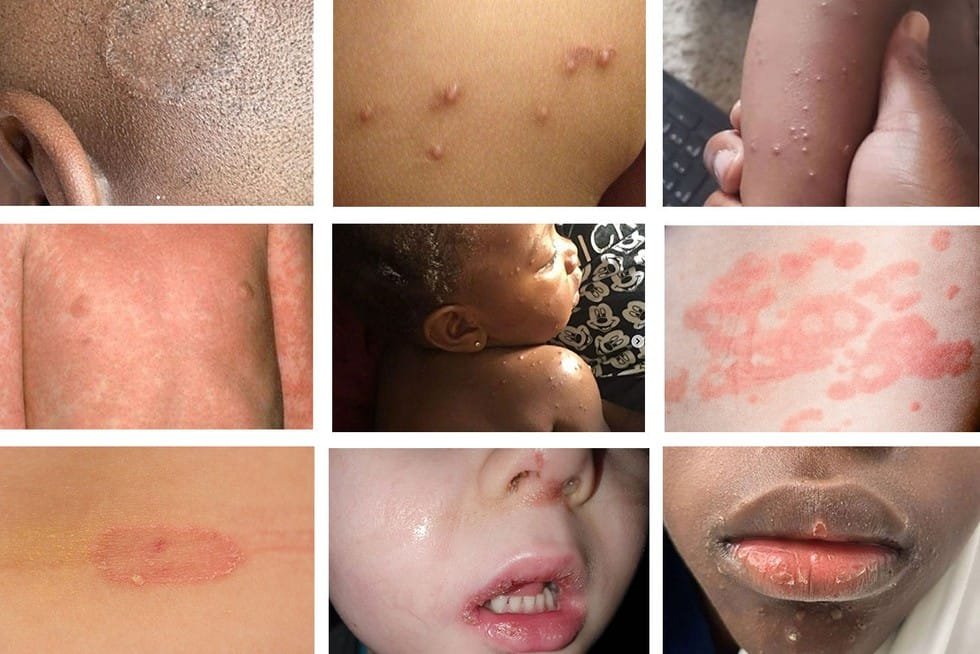
“Many children outgrow eczema, but in some cases, it can be extremely uncomfortable and require medical treatment.”
Contact Dermatitis and Impetigo
As a parent, you might see contact dermatitis and impetigo in your baby. Knowing about these can help you care for your child better.
Contact Dermatitis happens when something irritates your child’s skin. This can cause a drool rash that’s red, itchy, dry, or bumpy. Things like soaps, laundry detergent, or even drool can cause it.
Impetigo is a contagious skin infection. It shows up as red sores, often on the face, especially around the nose and mouth. It can start on healthy skin or spread from cuts or bites. Treatment might include an antibiotic ointment or oral antibiotics.
| Condition | Causes | Symptoms | Treatment |
|---|---|---|---|
| Contact Dermatitis | Irritants or allergens | Red, itchy, dry, or bumpy rash | Avoiding the trigger, using gentle skin care products |
| Impetigo | Staphylococcus aureus (80%), Group A Streptococcus (10%) | Red sores, especially around the nose and mouth | Antibiotic ointment or oral antibiotics |
It’s key to tackle these baby skin irritations quickly. This stops contagious skin infections from spreading and keeps your child comfortable. By knowing the causes, symptoms, and treatments, you can keep your baby’s skin healthy and happy.
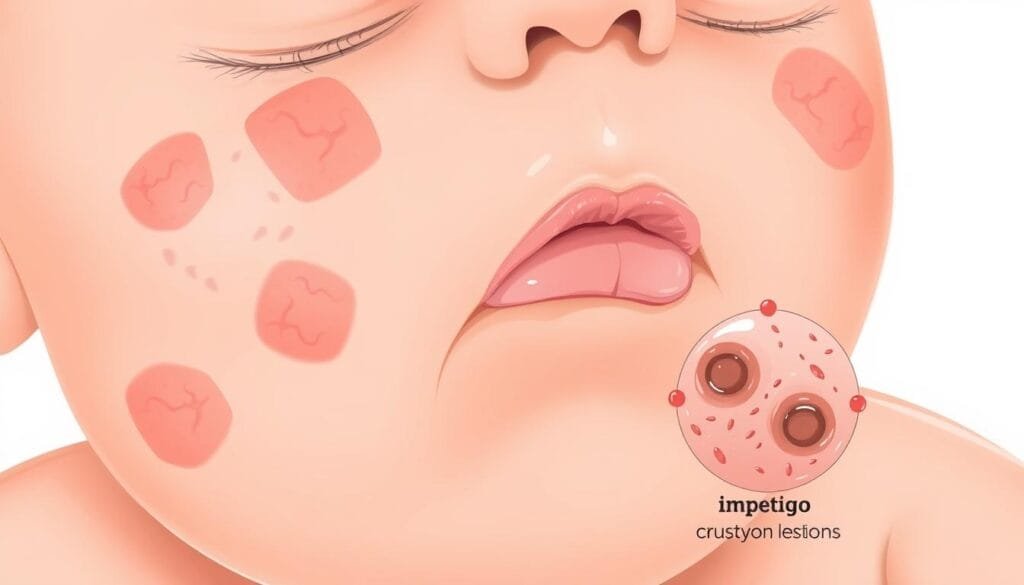
Prevention and Management Strategies
Gentle Skin Care and Moisture
When caring for your baby’s skin, remember “less is more.” Newborn skin is very sensitive. Use fragrance-free, hypoallergenic products to avoid irritation.
Bathing should be minimal. Use warm water and gentle cleansers. After bathing, pat dry and apply fragrance-free lotion or petroleum jelly to keep moisture in.
Keeping your baby’s skin moist is key. Premature babies especially need moisturizers to help their skin. Apply a thin layer of petroleum jelly or unscented lotion to keep their skin hydrated.
Proper diapering and frequent changes are vital for preventing skin issues like diaper rash. Use barrier creams or ointments to protect the skin. A little prevention can keep your baby’s skin happy and healthy.
| Skin Care Tip | Benefits |
|---|---|
| Minimize bathing frequency | Helps maintain natural skin moisture and barrier function |
| Use fragrance-free, hypoallergenic products | Reduces risk of skin irritation and allergic reactions |
| Apply moisturizing lotions or petroleum jelly | Locks in moisture and strengthens the skin’s protective barrier |
| Frequent diaper changes and use of barrier creams | Prevents and manages diaper rash |
By following these gentle skin care practices, you can prevent and manage common baby skin conditions. This ensures your baby’s comfort and overall skin health.
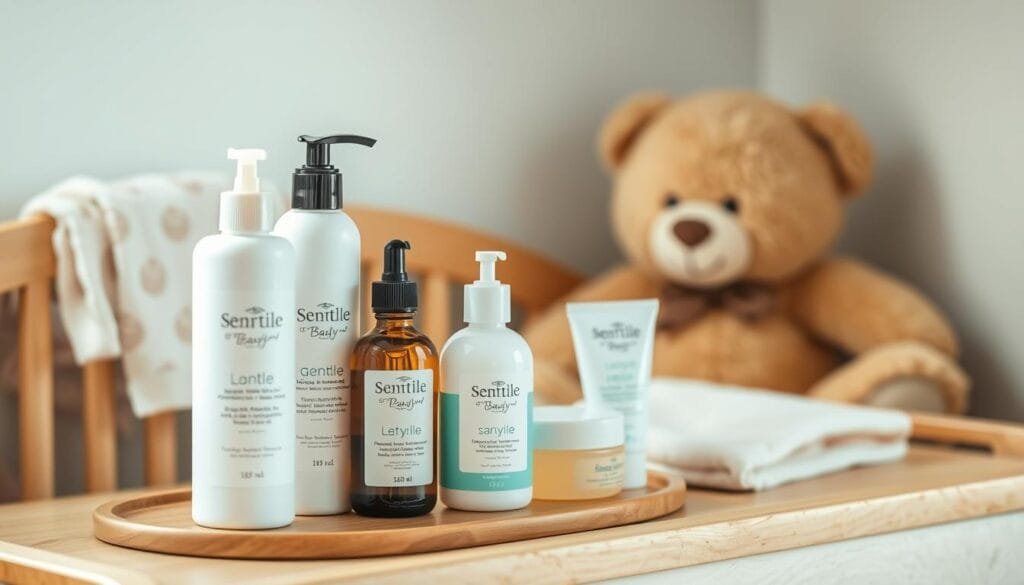
When to Seek Medical Advice
Many baby skin issues are not serious and go away by themselves. But, knowing when to see a doctor is key. If a rash doesn’t get better, gets worse, or has pus, it’s time to call the doctor. Also, if cradle cap gets bad or eczema is very itchy, you should talk to a pediatrician.
Parents can call their doctor’s office and ask to talk to a nurse if they’re worried about a skin condition. Some serious signs that need a doctor’s visit include:
- Rashes that don’t get better or get worse
- Rashes with fever, pus, or too much irritation
- Severe cases of cradle cap or eczema
It’s wise to be proactive and contact the pediatrician about newborn rashes if unsure. Early action can stop problems and make sure your baby’s skin issues are handled right.
“Up to 60% of people with eczema develop it in their first year of life, and up to 25% of all children have the condition according to the American Academy of Dermatology Association (AAD).”
By watching closely and getting medical help when needed, you can keep your baby’s skin healthy and comfy.
Conclusion
Newborn skin is delicate and can get various conditions. These include harmless rashes like milia and erythema toxicum, and serious ones like eczema and impetigo. Knowing about these can help parents take care of their baby’s skin, keeping them comfortable and safe.
It’s crucial to understand newborn skin care. Baby skin loses moisture quickly and can easily get damaged. This is why using gentle, fragrance-free products is key to keeping their skin moist.
Parents should use gentle products, keep their baby’s skin moist, and get medical help when needed. With the right care, baby’s skin stays healthy and happy. This helps avoid problems and keeps their environment comfortable and soothing.
FAQ
What are some common baby skin conditions?
What are milia and baby acne?
What are erythema toxicum and pustular melanosis?
What is cradle cap and eczema?
What is contact dermatitis and impetigo?
How should parents care for their baby’s skin?
When should parents seek medical advice for their baby’s skin?
Source Links
- Skin Conditions in Newborns | Advice for New Parents – https://www.cincinnatichildrens.org/health/s/skin-conditions-newborn
- Newborn Skin 101 – https://www.hopkinsmedicine.org/health/wellness-and-prevention/newborn-skin-101
- Baby’s First Year: Navigating Common Pediatric Skin Issues – https://plymouthmeetingdermatology.com/pediatric-skin-issues/
- Skin care for your baby – https://www.ncbi.nlm.nih.gov/pmc/articles/PMC2528704/
- Common Skin Rashes in Children – https://www.aafp.org/pubs/afp/issues/2015/0801/p211.html
- When to worry about a baby’s rash – https://www.mayoclinic.org/healthy-lifestyle/infant-and-toddler-health/in-depth/baby-rashes/art-20546833
- What causes milia in newborns? – https://www.babycenter.com/health/conditions/what-causes-milia-in-newborns_10894
- Baby Acne: What Parents Need To Know – Riverchase Dermatology – https://www.riverchasedermatology.com/blog/baby-acne-what-parents-need-to-know/
- Erythema Toxicum – StatPearls – NCBI Bookshelf – https://www.ncbi.nlm.nih.gov/books/NBK470222/
- Benign skin disease with pustules in the newborn – https://www.ncbi.nlm.nih.gov/pmc/articles/PMC4861557/
- Common skin conditions in babies – Mayo Clinic Press – https://mcpress.mayoclinic.org/parenting/common-skin-conditions-in-babies/
- Common Skin Conditions & Rashes in Children: Causes & Treatment – https://my.clevelandclinic.org/health/diseases/6951-skin-conditions-in-children
- Impetigo, Contagious Skin Infection: Causes, Treatment & Prevention – https://my.clevelandclinic.org/health/diseases/15134-impetigo
- Impetigo-Impetigo – Symptoms & causes – Mayo Clinic – https://www.mayoclinic.org/diseases-conditions/impetigo/symptoms-causes/syc-20352352
- Baby Skin Care — Simple Tips to Keep Your Baby’s Skin Healthy – https://www.webmd.com/parenting/baby/ss/slideshow-baby-skin-care
- Baby Skin Care: Tips for Your Newborn – https://www.webmd.com/parenting/baby/skin-care-tips
- When to Worry About a Child’s Rash – https://www.hopkinsmedicine.org/health/wellness-and-prevention/when-to-worry-about-a-childs-rash
- Baby rash: Causes and when to see a doctor – https://www.medicalnewstoday.com/articles/baby-rash
- Rashes in babies and children – https://www.nhs.uk/conditions/rashes-babies-and-children/
- Newborn Skin: Common Skin Problems – https://www.ncbi.nlm.nih.gov/pmc/articles/PMC5574071/
- Short-term skin problems in infants aged 0–3 months affect food allergies or atopic dermatitis until 2 years of age, among infants of the general population – https://www.ncbi.nlm.nih.gov/pmc/articles/PMC6880577/
- How Does Infant Skin Differ from Adult Skin? – https://www.medscape.org/viewarticle/743529








